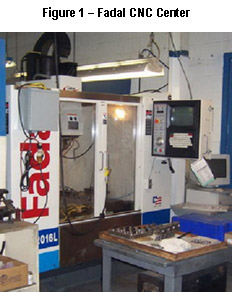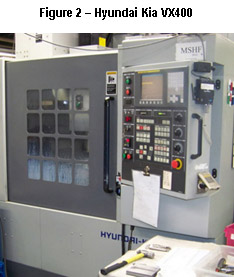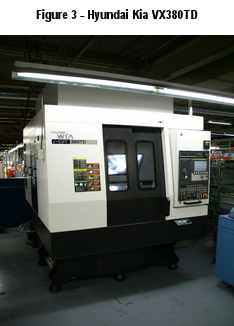For one Connecticut manufacturer of close tolerance precision stamped and coiled metal parts, an 8-year journey to provide its customers with higher precision parts from progressive tools has reached a happy ending, with the incorporation of in-house CNC machining that allows them to stamp parts at a very low cost, and then machine crucial features into them. In just a few short years, the company jumped from one used machining center to 12 new centers, including some highly automated centers with the potential to reduce cut times by nearly a third, while maintaining tolerance and finish requirements.
What differentiates the Farmington, CT-based Connecticut Spring & Stamping (CSS)'s approach from traditional machining suppliers is that stamping and then machining results in a much lower cost part than a fully machined part. Also noteworthy is that, by doing all of the processing in house, CSS controls all aspects of the part, from prototyping and development to final production. Designing and building both the progressive tooling for the stamping and the fixtures required for the machining process helps CSS meet the quality requirements of its customers, especially those in the medical device industry.
It all began in 2004, when CSS began to see more and more customers looking to get higher precision parts off a progressive tool. Customers were looking for their existing parts to have only a few critical to function features held to closer tolerances. CSS had decided that CNC machining was the way to go, and began researching and learning all it could about the process. They jumped in to the CNC world by purchasing a used Fadal machining center (see Figure 1) , engineered and designed their own fixtures, and were off and running.
, engineered and designed their own fixtures, and were off and running.
According to Mike Vanadestine, CSS Self Directed Work Team Leader-CNC, "The initial customer for this process, a major firearms manufacturer that needed a machined safety, was very happy with the quality of the parts and remains so to this day."
He explains that the "one stop shop" process CSS uses differentiates them from the traditional CNC machining suppliers. "We have the in-house engineering personnel who can aid in any redesign or alterations needed to achieve the functional requirements directed by our customers."
This gives CSS an advantage because the customer needs to partner with only one vendor. "We are able to take a stamped part and then machine critical features, and this can be done at a considerably lower cost than having to machine the complete component," says Vanadestine.
As the word spread that CSS could machine stamped parts, the company began to get requests from other customers looking for the same accuracy and finish that the CNC machines were producing, so they started looking at additional machines to keep up with the demand.
In 2009, the stakes were raised higher, as CSS found itself with new medical customers looking for even tighter tolerances than had been achieved before.
Robert Allen, CSS Director of Engineering, Tooling and Metal Form, notes that they were no longer looking at holding +/- .003 tolerances, but instead were asked to hold tolerances of +/- .0005. To achieve these close tolerances would require a very accurate CNC machine, and, after doing a great deal of research, they settled on the Hyundai Kia VX400 (See Figure 2).

"These machines are significantly more accurate than our first machines and are able to hold tighter tolerances all day, every day. We have also taken on a 5-axis machining job using a rotary table and all the machine's capabilities."
For example, CSS recently worked with a significant medical device company that had been purchasing one of its parts as a completely machined tube, but wanted to explore the possibility of moving to a stamped part with machined features. The project is tricky, since the tube has important features that had to be duplicated in a stamped part. A pin has to smoothly ride on a surface to create the torque necessary to grab tissue. Also, there could be no bumps or ridges that might cause the tube to skip or the surgeon to feel tension. Finally, a coined feature was needed where wires can be attached that made the instrument head articulate.
CSS began to re-design the new tube using 3-D solid modeling software (SolidWorks). Working with the customer's critical to function features CSS engineers successfully moved towards changing to a stamped part, finishing the critical features using its CNC machining process. The result is a savings of about $6 per part, a great result for the customer, which manufactures about 100,000 of the parts per year.
As CSS gains more experience in CNC machining, they began to look closer at cycle times to increase machine output. We started by looking at the fixture loading process. So, in 2011, they kicked their machining abilities up another notch by purchasing two new Hyundai Kia VX380TD machines, which use a rotary type table to shuttle parts in and out of the work zone. See Figure 3.
The operator will no longer be taking fixtures in and out; instead there are 2 fixtures mounted directly to the machine base and is shuttled in. CNC personnel at CSS are always on the lookout for new cutter technology along with increased feeds and speeds that will add to the efficiency of the cycle times. These new machines have the potential of cutting 25 to 30 percent off the company's current cycle times, all the while maintaining tolerance and finish requirements. But they are not stopping there. Says Allen, "We are currently expanding our CNC department and capabilities with the addition of the Hyundai Kia VX380TD machines. We will have 12 vertical machining centers and are also making room for additional machines as we continue to grow this very technical aspect of our business."